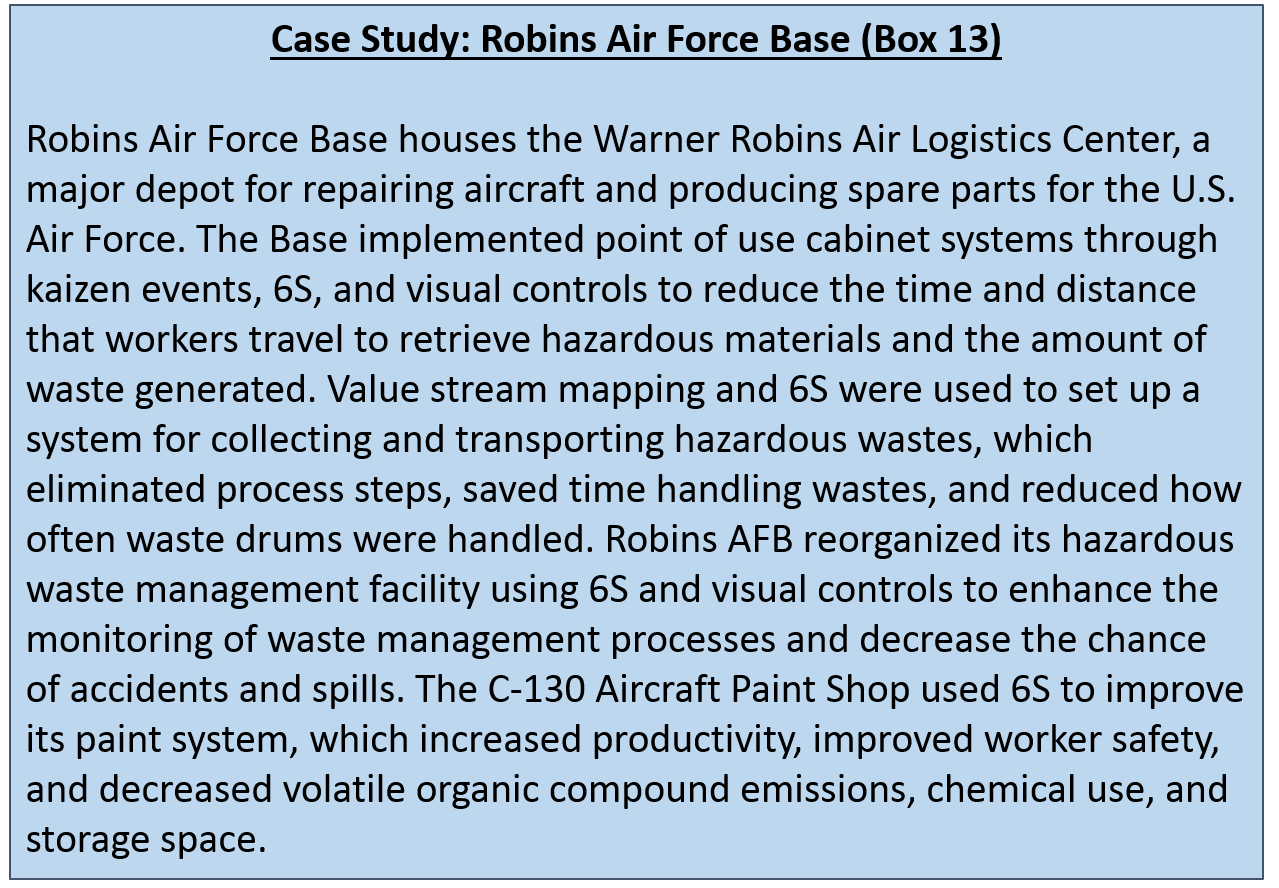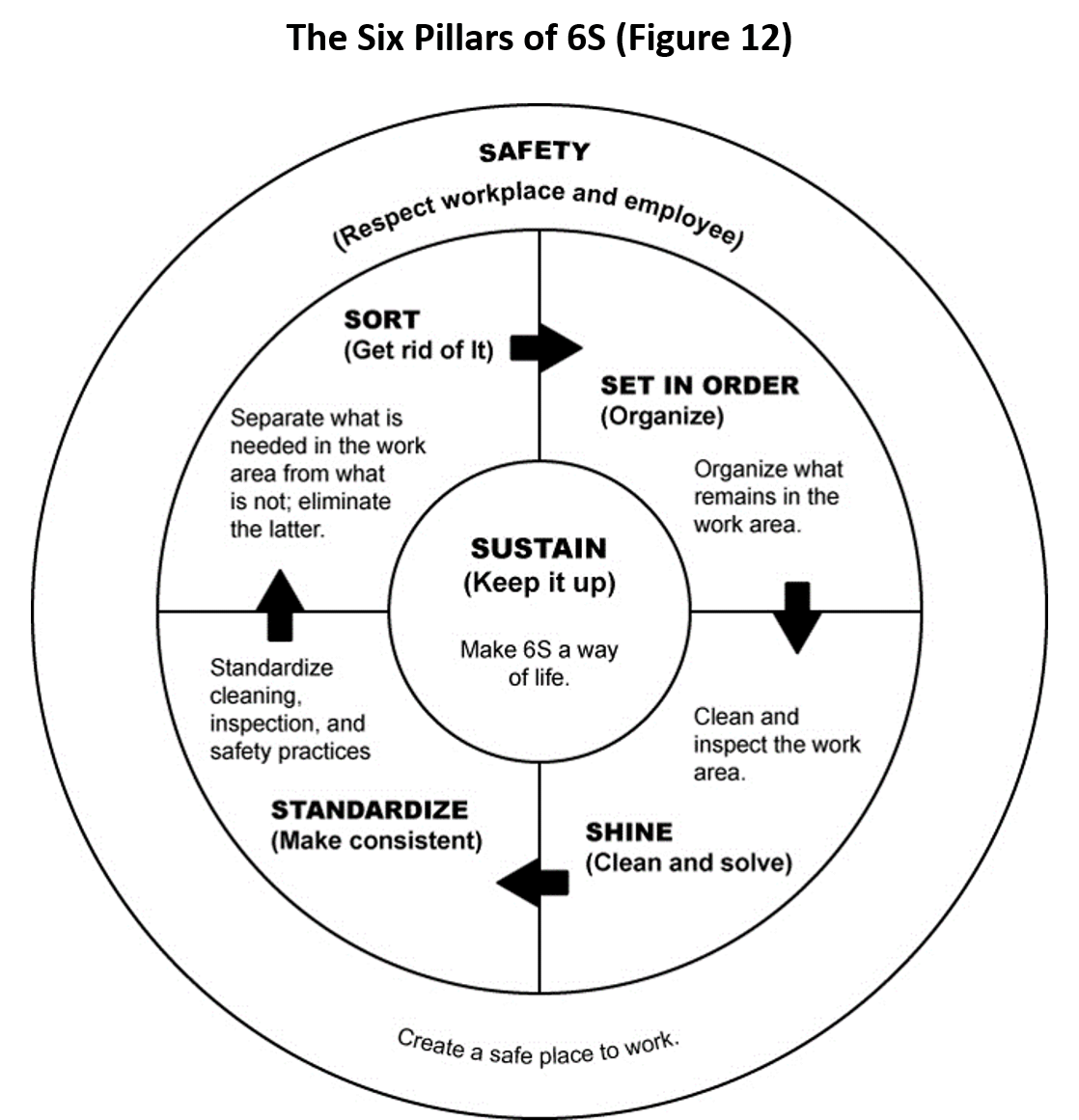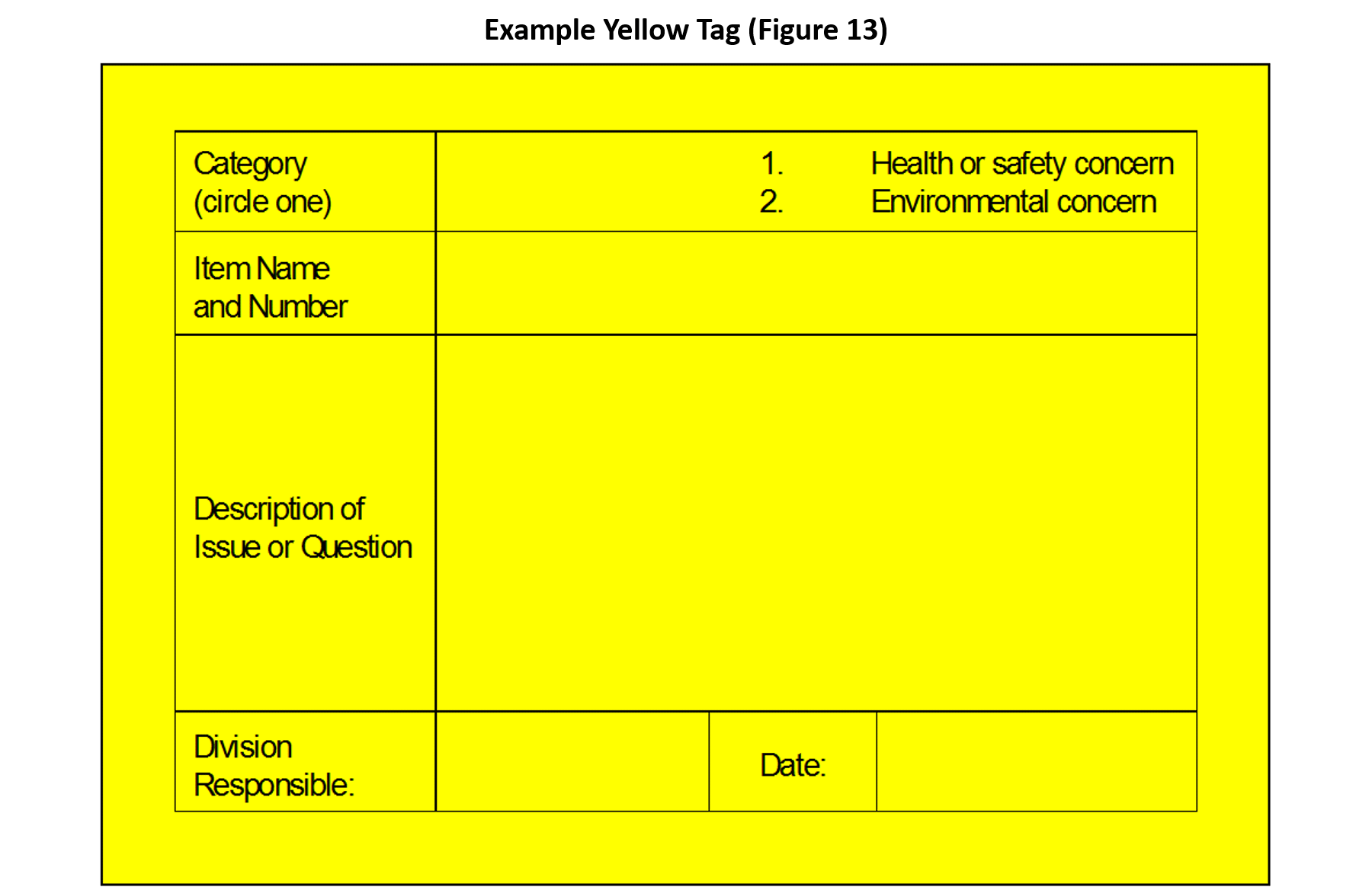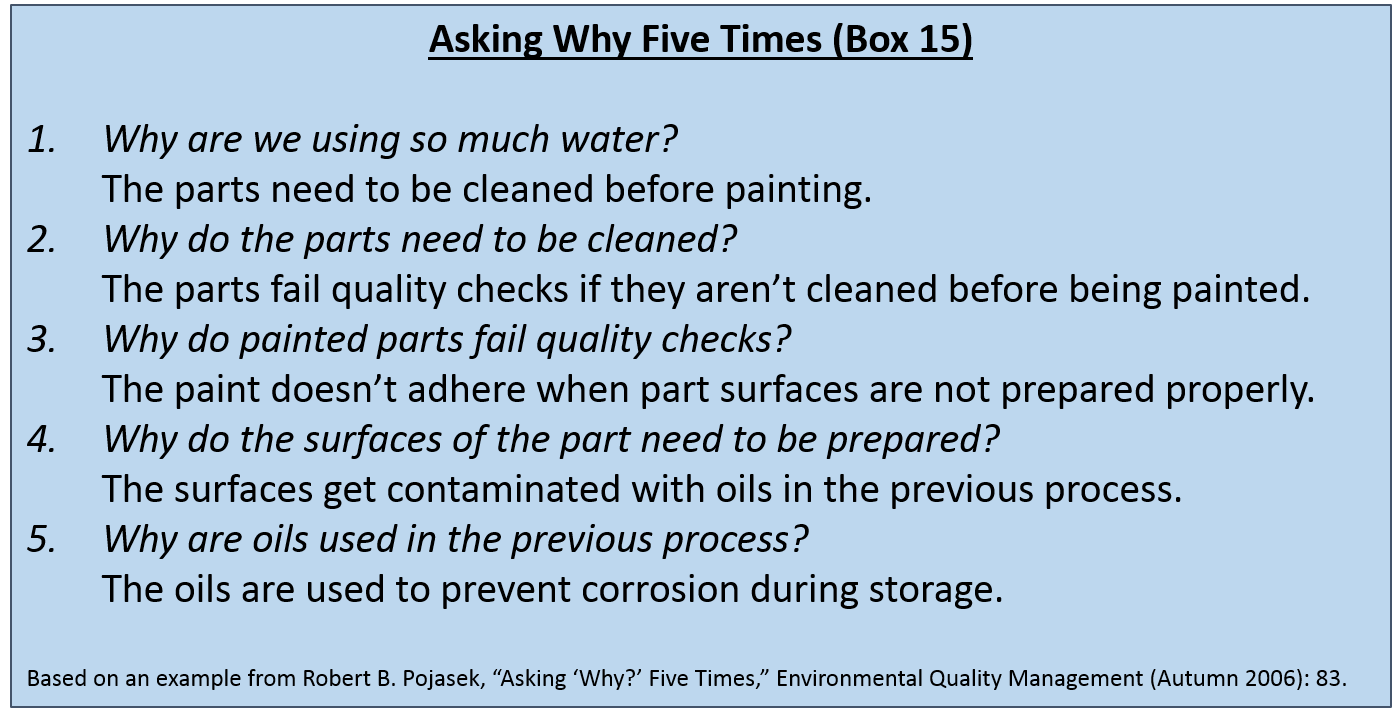Lean & Environment Toolkit: Chapter 5
6S (5S+Safety)
- Introduction to 6S
- How to Identify EHS Issues During “Sort”
- How to Incorporate EHS into 6S Inspections
- Plant-Wide 6S Inspection Checklists and Audit Questions
- Shine Checklists for Specific Work Areas
- Conclusion
- Toolkit Navigation
Introduction to 6S
This chapter focuses on making improvements to work areas using 6S, a variation of the 5S method. 6S can be a powerful way to reduce risks, improve waste management, and ensure that your facility is a safe and healthy place to work.
Definition of 6S

The Six Pillars of 6S

- Sort (Get rid of it): Separate what is needed in the work area from what is not; eliminate the latter.
- Set in order (Organize): Organize what remains in the work area.
- Shine (Clean and solve): Clean and inspect the work area.
- Safety (Respect workplace and employee): Create a safe place to work.
- Standardize (Make consistent): Standardize cleaning, inspection, and safety practices.
- Sustain (Keep it up): Make 6S a way of life.



What This Chapter Will Help You Do

Expanding the scope of 6S to include EHS concerns can help your company to:
- Make defects less likely, so less energy and materials are wasted;
- Reduce the chance that paint, solvent, or other chemicals expire or become off-specification before they can be used and then require disposal;
- Save floor space, which makes it possible to save energy costs by consolidating operations and closing unneeded storage areas;
- Avoid productivity losses from injuries and occupational health hazards by providing clean and accident-free work areas; and
- Prevent environmental and occupational health and safety compliance issues by preventing or quickly correcting any spill or leaks.
EHS issues are relevant to all six pillars of 6S. As a starting point, this toolkit describes how to:
- Distinguish between hazardous and nonhazardous items in your work area during Sort—an initial step in 6S. Use yellow tags or other visual cues in red-tagging to identify EHS issues, harmful materials, and environmental wastes.
- Incorporate questions about EHS issues into the inspection and evaluation activities that occur in the Shine and Sustain pillars. Inspect work areas in plant-wide and area-specific 6S inspections and audits to make sure that EHS concerns are managed properly.
Some additional ideas on how to incorporate EHS concerns into the 6S process are given in the box below.

How to Identify EHS Issues during “Sort”
Overview of Yellow-Tagging
The objective of Sort is to identify items that are not needed in a work area and to get rid of them. This is done through a process called red-tagging. During a red-tagging project, you can examine your work area to identify any environmental, health, and safety issues at the same time, using yellow tags or other visual cues.


- Identify yellow-tag targets and criteria.
- Make and attach yellow tags.
- Evaluate and take care of yellow-tagged items.
- Document the results.
Step 1: Identify Yellow-Tag Targets and Criteria

Potential items to consider in yellow-tagging include:
- EHS hazards in the workplace;
- Chemicals and other hazardous materials; and
- Environmental wastes.
After choosing targets, your team should agree on criteria for evaluating yellow-tagged items. You can continue to use red-tagging and your company’s red-tag criteria to determine whether an item is needed in the work area based on its usefulness for the work at hand, the frequency with which it is used, and the quantity that is needed. For yellow tags, you may want to use criteria related to the risk of an item, the availability of alternative materials or equipment, or to an opportunity for improved environmental performance.

Step 2: Make and Attach Yellow Tags


It is best to attach yellow tags to items during a short, focused event, to get a snapshot of the current state of the work area. Unless there is an immediate danger to people’s safety, do not spend time at this stage correcting issues or evaluating what to do with items. Instead, use the yellow tags to highlight potential EHS issues or opportunities in the target work area.
Step 3: Evaluate and Take Care of Yellow-Tagged Items
The next step involves applying the criteria from Step 1 to determine what to do with yellow-tagged items.
- If you found a safety, health, or environmental issue while yellow-tagging, such as a compliance violation or excess environmental waste, ask “why” five times to identify the root cause of it (see example below) and then ask “how” to address it.
- If an item is both unnecessary (red-tagged) and hazardous (yellow-tagged), be sure to follow appropriate procedures for disposal of hazardous wastes.
- If there are hazardous items remaining in a work area after doing Sort (items with a yellow tag but not a red tag), find out whether you can avoid the need to use those materials, or whether there is a less toxic alternative.

Step 4: Document Results
The final step in a yellow-tag strategy is to document necessary information from the yellow-tagging process in a log book or other tracking system your company uses. This should be done at the same time as you record data from red tags, ideally as part of the same system. This will allow you to track the improvements and savings that have resulted from your yellow-tagging efforts.
As with any Lean project, it is important to share your results with others, celebrate your success, and identify any follow-up items. Posting the results of yellow-tagging projects on activity boards can show others at your company what you have been able to achieve and can generate ideas for further improvement.
How to Incorporate EHS into 6S Inspections
Eliminating Environmental Waste and Risk through 6S Inspections
Most companies who implement 6S seek to sustain the improvements made during initial 6S events. Shine activities often include daily cleaning and inspection by workers in their work area. Sustain activities often include weekly or other periodic audits to assess progress with 6S implementation.

Plant-Wide 6S Inspection Checklists and Audit Questions
Inspection checklists and audit questions are powerful tools to sustain 6S improvements and to prompt the identification of new improvement opportunities.


These questions can be adapted to work in a variety of 6S implementation assessment tools, particularly where a common system is used to assess 6S implementation across many work areas. Your company may use a simplified rating system to assess 6S implementation progress, such as a 0–5 rating for each 6S pillar. In this case, these questions can be used to train 6S inspectors and auditors, or to provide background information for a broader rating category or question that focuses on overall efforts to address EHS issues and opportunities in a work area.

Shine Checklists for Specific Work Areas

Conclusion
Summary
6S is modeled after the 5S system designed to reduce waste and optimize productivity through maintaining a clean, orderly workplace and using visual cues to achieve more consistent operational results. 6S uses the 5S pillars with an additional pillar for safety. The six pillars of 6S are:
- Sort (Get rid of it);
- Set in order (Organize);
- Shine (Clean and solve);
- Safety (Respect workplace and employee);
- Standardize (Make consistent); and
- Sustain (Keep it up).
The pillars work together to increase productivity, reduce defects, make accidents less likely, save time, and reduce costs. When expanded to include EHS issues, they can also help reduce hazards and improve environmental performance.
The following four steps provide an example of how EHS issues can be identified and addressed through 6S using yellow tags along with red tags in the Sort process. The objective of this strategy is to identify environmental wastes in the work area with a yellow tag, evaluate their need and potential alternatives, and address them accordingly.
- Identify yellow-tag targets such as EHS hazards, chemicals and other hazardous materials, and environmental wastes. Also, agree on criteria for evaluating yellow-tagged items.
- Make and attach yellow tags to identified items and include data to allow for evaluation of performance improvements.
- Evaluate and address yellow-tagged items.
- Document results.
By explicitly incorporating EHS issues into all six pillars during 6S inspections, you can eliminate more waste and risk. Inspection checklists and audit questions are powerful tools to sustain 6S improvements and to prompt identification of new improvement opportunities.
Toolkit Navigation
- Contents & Acknowledgements
- Preface
- Chapter 1: Introduction: Getting Started with Lean & Environment
- Chapter 2: Identifying Environmental Waste
- Chapter 3: Value Stream Mapping
- Chapter 4: Kaizen Events
- Chapter 5: 6S (5S + Safety)
- Chapter 6: Conclusion and Implementation Strategies
- Appendix A: Lean Methods
- Appendix B: Basic Environmental Measures for Lean Enterprises
- Appendix C: Lean Event EHS Checklist
- Appendix D: Pollution Prevention Resources
- Appendix E: 6S Safety Audit Checklist
